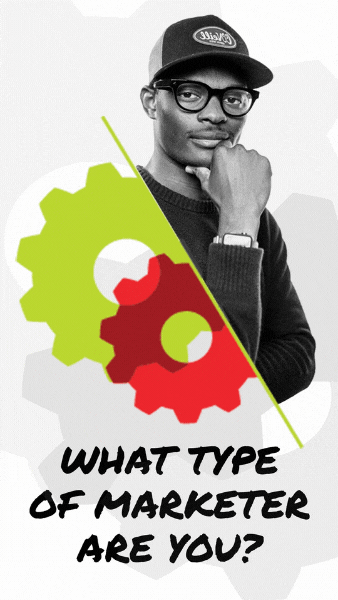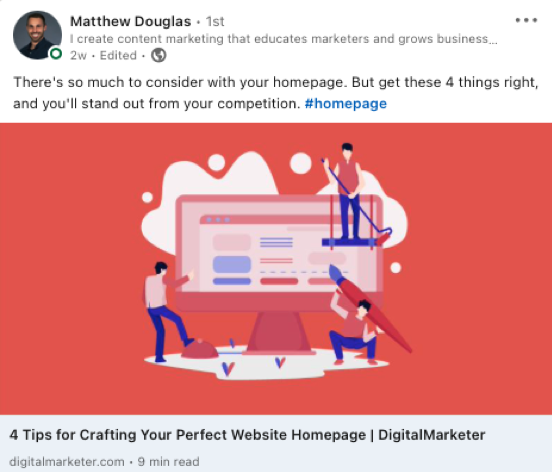You’ve heard LinkedIn is an engagement gold mine.
Maybe Gary Vee convinced you it was a good idea, or you heard a few too many people talk about how LinkedIn was their number one source for finding B2B clients.
LinkedIn is talked about as an underrated platform. Like TikTok, LinkedIn posts can actually go viral (take the hint Facebook and Instagram). The thing is, you’re not going viral on a platform with all types of users.
You’re going viral on a platform where everyone is there to talk about business. Hence, the goldmine.
As a B2B business, we can’t ignore the potential of LinkedIn. DigitalMarketer’s Senior Social Media Manager, Shannon Goodell, has been strategizing and implementing on LinkedIn. Recently, she stumbled on some serious success.
Over two million impressions, almost 100,000 engagements, and 62,000 post clicks (!).
Shannon’s narrowed down our strategy to 3 effective ways to increase impressions, engagement, and post clicks on LinkedIn. Time to go panning for gold.
#1: Find LinkedIn Posts in Previously Published Content
The first step of creating LinkedIn content is realizing you don’t need to create LinkedIn content. You already have content that could be used on LinkedIn. It just hasn’t been put into a LinkedIn-friendly format. As Shannon explains,
“Pull out tips and advice from your blog posts, Lead Magnets, podcasts, courses, playbooks, workshops, etc., and post as text-only posts. Add the link to the resource or resources in the comments and direct people to check out the comments for the link(s) to learn more.”
This is how Shannon has been able to create more DigitalMarketer content…without creating more DigitalMarketer content. It’s the beauty of splintering—every piece of content you create for your brand can be turned into at least 10 other pieces of content for other platforms.
“This is a super simple post to create, and it works! If you don’t have a lot of content to mine, post your own tips and advice and also ask your team members for theirs (based on their areas of expertise).”
Here are two of Shannon’s tips for splintering content into LinkedIn posts:
- You can use fewer characters on LinkedIn than on Facebook, so make sure to edit your copy so the post can be read clearly and easily
- If you can’t figure out how to make a post work with the number of characters given, just post one tip at a time
Splintering content is a great strategy for LinkedIn… and every other platform you’re creating content for. You don’t need to create a brand-new post every time you change platforms. You just need to make your content native to the platform you’re posting on.
This means you don’t want to post a long, all text LinkedIn post to your Instagram stories. People are on Instagram stories to see movement and engage with their phone (think GIFs and stickers). Your Instagram story content can be a team member breaking down the post with a talking head selfie video or a graphic that explains what your LinkedIn post did—but more aesthetically for the ‘gram.
Splintering content can turn a blog post into:
- A LinkedIn post
- An Instagram feed post
- An Instagram story
- An Instagram IGTV
- An Instagram Reel
- An Instagram Live
- A Twitter thread
- A TikTok
- A YouTube video
- A podcast episode
- A Facebook post
- A Facebook Live
The wild part about this list is that we can keep going. We haven’t even mentioned Fleets or YouTube stories.
Use your previously posted content to create a stream of LinkedIn posts. Make your posts extra fancy by turning them into (free!) downloadable documents, as Shannon explains below.
#2: Create Downloadable Documents (Not Opt-In Lead Magnets)
The key is in the parenthesis. These aren’t lead magnets where users opt-in to your email list to get the resource. You’re just going to give them the resource. We know this goes against your marketing brain, but the data doesn’t lie.
Two million impressions and over 62,000 link clicks tell us this strategy is working. We’re establishing trust with our audience and showing them how much value we give away for free (no opt-in required!).
As co-founder and CEO of DigitalMarketer Ryan Deiss says, if you give away your best stuff, people will be dying to know what you keep behind the paywall.
You don’t need a graphic design team to create these downloadable Google Docs. All you need to do is “copy and paste from a valuable resource (blog post, Playbooks, Lead Magnets, etc.) and add relevant links to the resource and calls-to-action in the doc. Title it appropriately, and you’re ready to go.”
Our docs are super simple and straight to the point. They’re focused on delivering value over taking up our graphic design team’s time.
Here are Shannon’s tips for creating these documents:
- Give Viewer access
- Use Grammarly to check your spelling and grammar
“Once ready to post, just hit “document” and choose “Google Drive.” LinkedIn will ask you for access, and then you can choose that Google doc to upload as a PDF. Title the PDF in LinkedIn and add your text copy and post! I also direct people to links in the comments to learn more.”
Save these documents for your content team to keep using. You can use these documents to outline more posts in the future. They’re a document today, but in a few weeks you could turn that content into a LinkedIn text post, a blog article, a podcast episode, a TikTok… okay, we’ll stop now. You get the point.
These documents are great for showing your audience how much you’re willing to give away for free (a strategy tried and tested with the Customer Value Journey and Customer Avatar Worksheet). When Ryan and the DigitalMarketer team first considered giving away our Customer Value Journey and Customer Avatar Worksheet for free, it felt like too much. We were giving away our secret sauce. What would people pay us for?
It turns out the opposite was true. We had given away some of our best stuff, and in return, people wanted to pay us to know more. If that’s what we would give for free, they couldn’t imagine what was hiding on the other side of that paywall.
As much as it might feel like you should at least be asking for an email opt-in, you’ll have to trust us and karma on this one.
#3: Lean into Employee-Generated Content
Your LinkedIn content has been splintered from other posts, but now you want to get as much engagement on it as possible. It’s time to lean on your team. If you’re not utilizing employee-generated content yet—the time to start is now.
Employee-generated content gets higher engagement, follows, and conversions than branded content. Brands like Morning Brew show us the importance of putting faces to your brand, creating an audience-attracting magnet acquired for $75 million.
The key to getting employees to share branded content is to ask them. Without the green light to create company content, employees will avoid stepping on toes. They don’t want to get in trouble, and it’s safer not to take the risk. Leadership is a huge part of employee engagement.
Have your company’s leaders explain what employee-generated content is, how it can help the business, and what they’d love to see from employees in the future. In our case, we want our DigitalMarketer team to share our LinkedIn posts so we can get more impressions.
Here’s Matthew Douglas, our Content Manager of Sponsored Content, sharing a LinkedIn post highlighting an article published to the DigitalMarketer blog:
To organize the process of sharing the post with your team, use Shannon’s strategy:
“Create a Google doc with links to your recent company LinkedIn posts plus brand new copy divided into categories (sales, marketing, human resources, etc.). Include your company’s LinkedIn handle in all of the posts. Then share with your company.
Before you ask your team to engage with your branded content online, we have to make sure you’re clear on the goal. As Shannon explains,
“The goal here isn’t web traffic (although it can be an added benefit). It’s to get new people to your company page to explore and engage. The goal is to get them to share your previously published LinkedIn posts plus brand new posts that all tag your company’s LinkedIn.”
Obviously, web traffic is an important (massive) part of your LinkedIn strategy. But, your employee-generated content isn’t necessarily there to pull massive traffic. Your employees might only have a few engaged friends and family on LinkedIn—so don’t be hard on them if you’re not going viral because of their shares.
What you’re doing is getting your brand acquainted with more LinkedIn users. This is Stage 1 of the Customer Value Journey, Awareness. For someone to buy a product from you, they have to first know you exist. You don’t want to ask them to buy your products the second they find out about you. That’s like asking someone to marry you while they’re walking down the street. You have to let them warm up to you, ask for a first date, and then give them some time to decide you’re the right person for them.
Luckily business works faster than relationships that lead to marriage, but it’s still a relationship.
When your customer avatar discovers your brand through a colleague, friend, or family member, you’re walking into that relationship with established trust. That will help move new leads through your CVJ faster and help people get to know you, even if they don’t need your services. How many times have you referred someone to a brand without ever buying their products because you saw them online, and it seems to fit the solution your friend is asking about?
The answer is all the time. Position your brand in the same way by using employee-generated content.
We are not stopping this LinkedIn strategy anytime soon. Shannon has figured out how to increase our impressions, engagement, and post clicks, and we’re really excited about this strategy.
LinkedIn is an engagement goldmine for B2B businesses. Instead of pushing through the noise of every customer avatar in existence on other social platforms, you can focus on business-minded people on LinkedIn.
People don’t open LinkedIn to find recipes, see fancy car photos, or get inspired by home decor. They’re on LinkedIn with their business hat on.
And that sure seems like the best possible time to show them what you have to offer their business.





















